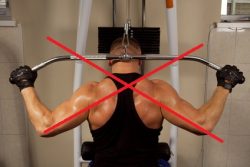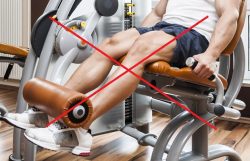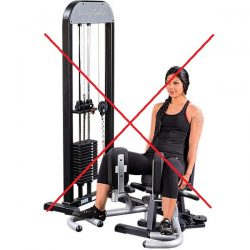Believe it or not, not ALL exercises are good for you. In fact some can be downright dangerous. What makes an exercise risky? Here are a few red flags to look out for:
- Any unusual or “unnatural” movement pattern in the exercise
- Any movement that causes pain or discomfort in any way
- Any movement that enhances muscular imbalances that are already present
- Any movement that requires joint flexibility that is above and beyond your range of motion
- Any exercise with risks of injury that outweigh the potential benefit of the exercise itself
Behind-the-Head Lat Pull-Downs
The problem: Pulling the bar behind the neck puts far too much stress on the shoulder joint, the amount of outward rotation on the humerus combined with pulling it downward means the top of the humerus is actually pushing outward and away from the shoulder joint, overstretching the tendons and ligaments on the front of the shoulder which can lead to injury – Especially considering that most of us are overly tight in the front of our shoulders due to all our time spent at desks and on computers.
Alternative: Train your lats safely while protecting the shoulder joint by pulling the bar in FRONT of you, just to chin level and then back.
Knee extension machine
The Problem: This exercise poses major risks to the knees when the weight is heavy and when the knees are fully extended. Lifting heavy weights with all the resistance focused at your ankles, is not what the knee was designed to do. If you have any kind of knee problem, or use a too much resistance during this exercise, it puts an extreme amount of shear stress on the knee joint, which can strain the tendons and overly compress the knee’s cartilage.
Alternative: Train your quads correctly, in conjunction with the other leg muscles as they were designed to be used. Compound movements like squats, lunges and step ups are great alternatives, and also use more muscles so burn more calories!
Inner and Outer Thigh Machine
The Problem: Using your inner and outer thighs to lift weight while in a seated position puts you at risk of straining these relatively small muscles and aggravating lower back and hip problems. Inner and outer thigh muscles are designed to support movement, not to be prime movers like they are in these types of exercises.
Alternative: Use your body weight and perform wide stance sumo squats, or simple leg abduction and adduction in standing or lying positions to avoid over-stressing these muscles!



